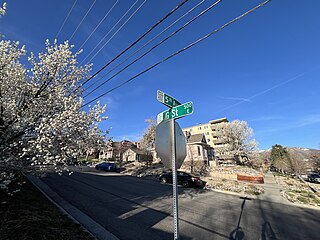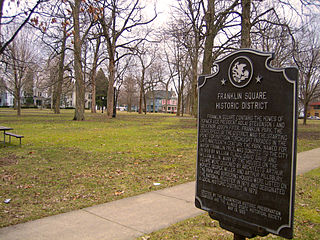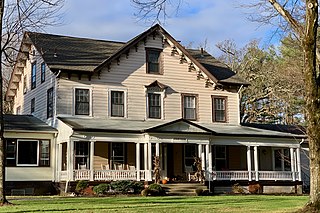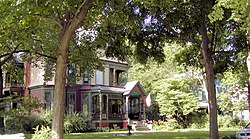
Bloomington is a city in and the county seat of McLean County, Illinois, United States. The 2020 census showed the city had a population of 78,680, making it the 13th-most populous city in Illinois and the fifth-most populous outside the Chicago metropolitan area. It is adjacent to the town of Normal, and is the more populous of the two principal municipalities of the Bloomington–Normal metropolitan area, which has a population of roughly 170,000. Bloomington is 135 miles (217 km) southwest of Chicago and 162 miles (261 km) northeast of St. Louis. Bloomington is home to Illinois Wesleyan University and the headquarters for State Farm and Country Financial. Bloomington is also home to the minor league hockey team Bloomington Bison.

The Avenues is an affluent neighborhood in Salt Lake City, Utah. It is named after the perfectly gridlike, closely laid out roads called Avenues and Streets. First surveyed in the 1850s, the Avenues became Salt Lake City's first neighborhood. Today, the Avenues neighborhood is generally considered younger, more progressive, and somewhat "artsy" when compared to other neighborhoods. Many young professionals choose to live there due to the culture and easy commute to downtown.. It is also one of the most important strongholds of the Utah Democratic Party.

Franklin Square, or Franklin Park is located in Bloomington, Illinois, McLean County. Listed on the National Register of Historic Places, Franklin Square contains the homes of former Vice President Adlai Stevenson I and former Governor Joseph W. Fifer. In 1979 the square was designated as a local historic district. Located northeast of downtown Bloomington, the square encompasses the 300 and 400 blocks of E. Chestnut and E. Walnut streets and the 900 block of N. Prairie and N. McLean streets.

The White Place Historic District is a residential historic district in Bloomington, Illinois. The district includes houses on White Place, North Clinton Boulevard, and the east side of Fell Avenue bordered to the south by Empire Street and Emerson Street to the north. These houses were largely built between 1895 and 1928, and many of them were built shortly after S. R. White platted White Place. The homes in the district were designed in a variety of architectural styles; styles prominently featured in the district include Prairie School, American Craftsman, Colonial Revival, Victorian, and Spanish Colonial.

The Ruben M. Benjamin House is a house in Bloomington, Illinois. It is a two-story rectangular building, styled in the Classical Revival architectural motif. It was built in 1856 John L. Routt, who would become the first governor of Colorado. Ruben M. Benjamin, an attorney known for litigation relating to railroad regulation, lived in the home for more than 60 years. The United States National Register of Historic Places added the Ruben M. Benjamin House in August 1978.

The North State Street Historic District is a nationally designated historic district in Monticello, Piatt County, Illinois. The residential district is centered on State Street north of downtown Monticello; it includes 77 buildings, 56 of which are considered contributing to its historic character. The houses in the district represent the variety of architectural styles seen in Monticello from 1870 to 1948, the ages of the oldest and newest houses. The oldest houses in the district are designed in the Gothic Revival and Queen Anne styles. In the early 20th century, Monticello experienced an economic boom due to growth in agriculture and the local patent medicine industry; its newly wealthy residents built homes on State Street, which became known locally as "Millionaire's Row". The majority of these new homes had Colonial Revival designs, as the style was nationally popular at the time; Colonial Revival is still the district's predominant architectural style. Other designs featured in the district include Craftsman, Tudor Revival, and a Lustron house built in 1948. The district also includes several vernacular house types, such as the I-house and the bungalow.

In the law regulating historic districts in the United States, a contributing property or contributing resource is any building, object, or structure which adds to the historical integrity or architectural qualities that make the historic district significant. Government agencies, at the state, national, and local level in the United States, have differing definitions of what constitutes a contributing property but there are common characteristics. Local laws often regulate the changes that can be made to contributing structures within designated historic districts. The first local ordinances dealing with the alteration of buildings within historic districts was enacted in Charleston, South Carolina in 1931.

Beaufort Historic District is a historic district in Beaufort, South Carolina. It was listed on the National Register of Historic Places in 1969, and was declared a National Historic Landmark in 1973.

The Medbury's–Grove Lawn Subdivisions Historic District is a residential historic district located in Highland Park, Michigan. It runs along three east–west streets: Eason Street, Moss Street, and Puritan Street, from Hamilton Avenue on the west to Woodward Avenue on the east. The district was listed on the National Register of Historic Places in 1988.

There are nine historic districts in Meridian, Mississippi. Each of these districts is listed on the National Register of Historic Places. One district, Meridian Downtown Historic District, is a combination of two older districts, Meridian Urban Center Historic District and Union Station Historic District. Many architectural styles are present in the districts, most from the late 19th century and early 20th century, including Queen Anne, Colonial Revival, Italianate, Art Deco, Late Victorian, and Bungalow.

There are 77 properties listed on the National Register of Historic Places in Albany, New York, United States. Six are additionally designated as National Historic Landmarks (NHLs), the most of any city in the state after New York City. Another 14 are historic districts, for which 20 of the listings are also contributing properties. Two properties, both buildings, that had been listed in the past but have since been demolished have been delisted; one building that is also no longer extant remains listed.

Schooley's Mountain Historic District is a historic district along Schooley's Mountain, Pleasant Grove, and Flocktown Roads, and Heath Lane in the Schooley's Mountain section of Washington Township, Morris County, New Jersey. It was added to the National Register of Historic Places on June 14, 1991 for its significance in architecture, entertainment/recreation, and health/medicine. The district includes 71 contributing buildings, such as the Oak Cottage, site of schoolhouse No. 5, Schooley's Mountain Store, the William W. Marsh House, Christadelphian Bible Camp, the former Heath House Hotel, former Forest Grove Hydropathic Institute, Mine Hill Farm, the Marsh Mine and several private residences and commercial buildings.

The Hamburg Historic District, also known as the Gold Coast, is a residential neighborhood located on a bluff northwest of downtown Davenport, Iowa, United States. It is listed on the National Register of Historic Places in 1983. In 1999, it was listed on the Davenport Register of Historic Properties The historic district is where the city's middle and upper-income German community built their homes in the 19th and early 20th centuries. Germans were the largest ethnic group to settle in Davenport.

The East 14th Street Historic District is a neighborhood located on the east side of Davenport, Iowa, United States. It has been listed on the National Register of Historic Places since 1983.

The Steele Dunning Historic District is a neighborhood and historic district in Bloomington, Indiana, United States. Composed of small, single- or double-family houses, the district includes houses built from the late nineteenth century through the middle of the twentieth century.

The Vinegar Hill Historic District is a historic district and neighborhood in Bloomington, Indiana, United States. Built primarily in the second quarter of the twentieth century, and located a few blocks south of Indiana University Bloomington campus, Vinegar Hill has been the home of leading Indiana University faculty members. It has inspired literary attention, and it has been designated a historic site.

Oliver Johnson's Woods is a historic district and neighborhood on the northern side of Indianapolis, Indiana, United States. Located in southern Washington Township, the district occupies the site of what was once the family farm of Oliver Johnson. Born on the present site of the Indiana State Fairgrounds, Johnson grew up in a pioneer family that lived on the edge of the state capital city. Upon attaining adulthood, he bought property a short distance to the west, to which he moved in 1846. Here, he built a larger farmhouse in 1862, and he tilled the soil for most of the rest of his life. As Indianapolis grew northward, it reached the Johnson farm in the early twentieth century; the aged farmer and his sons saw the city's growth as an opportunity for financial gain, and in 1905 they announced the platting of 0.25 square miles (0.65 km2) of their property into individual lots. They chose an advantageous time to sell their property; as the new residents began to build their homes, an interurban railway was built along College Avenue on the district's western side that connected downtown with Broad Ripple. Many prosperous businessmen were attracted by the development's large lots and wooded streets; the city annexed Oliver Johnson's Woods in 1912, and by the outbreak of World War II, the streets were filled with large houses built in a wide variety of architectural styles. These early residents came from many different ethnicities: European immigrants were becoming more prosperous and leaving their ethnic enclaves, and new neighborhoods such as Oliver Johnson's Woods appealed to them. Among the neighborhood's leading residents was a colony of Jews of German descent.

The Cottage Home Historic District is a historic district and neighborhood located on the near east side of Indianapolis, Indiana. A small portion of Cottage Home is listed on the National Register of Historic Places while a larger area is listed on the state and local levels. Known for its preponderance of "cottage-style" homes built with strong Victorian influences, Cottage Home has historically been a working class neighborhood. Numerous industrial buildings are also scattered throughout the district, providing a base of economic activity. Today, however, many of these buildings are vacant, providing a special challenge to preservation and urban renewal efforts.

The Spring Grove Borough Historic District is a national historic district that is located in Spring Grove Borough in York County, Pennsylvania.

The Murphy–Hill Historic District encompasses the oldest residential portion of the city of El Dorado, Arkansas. It is located just north of the central business district, bounded on the north by East 5th Street, on the west by North Jefferson and North Jackson Avenues, on the east by North Madison Avenue, and on the south by East Peach and East Oak Streets. Six of the 76 houses in the 40-acre (16 ha) district were built before 1900, including the John Newton House, one of the first buildings to be built in El Dorado. Of particular note from this early period is a highly elaborate Queen Anne Victorian at 326 Church Street.






















